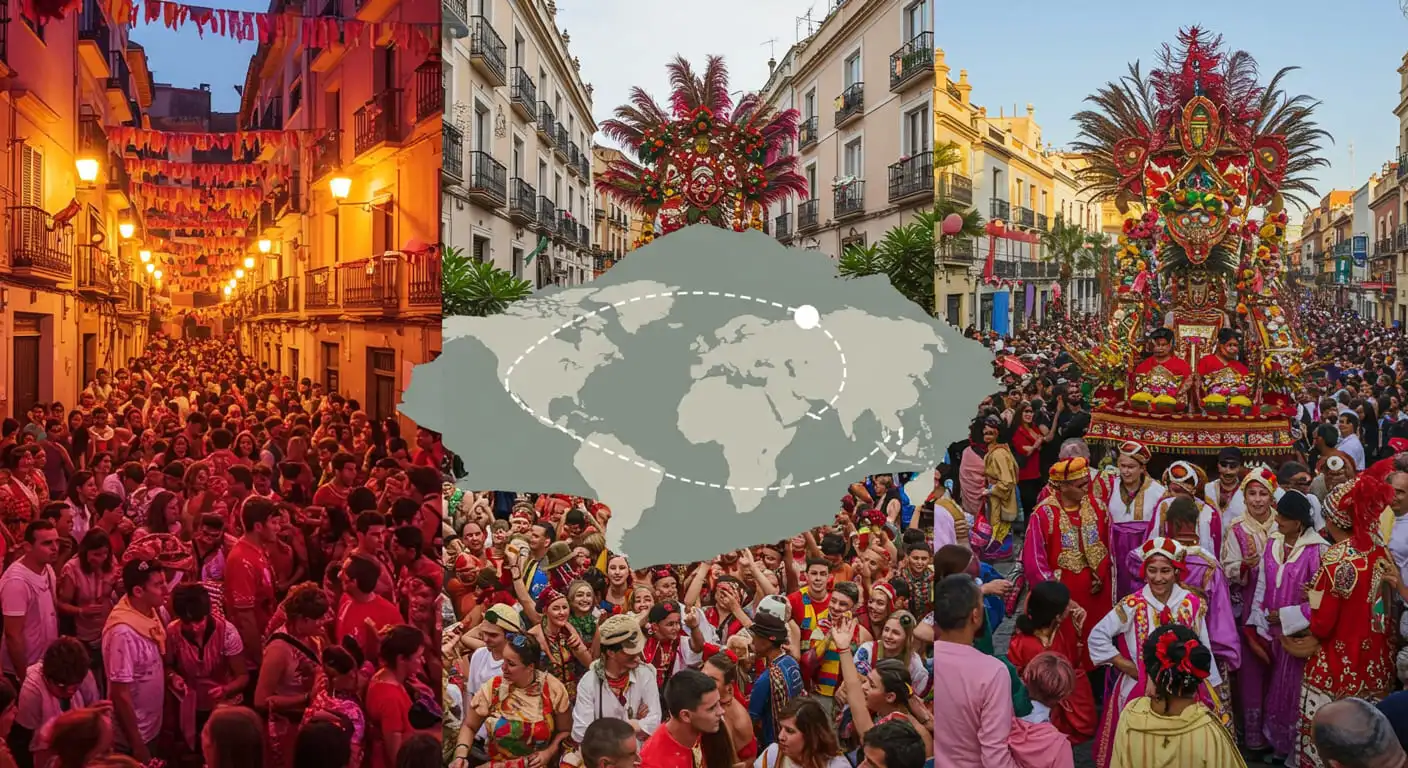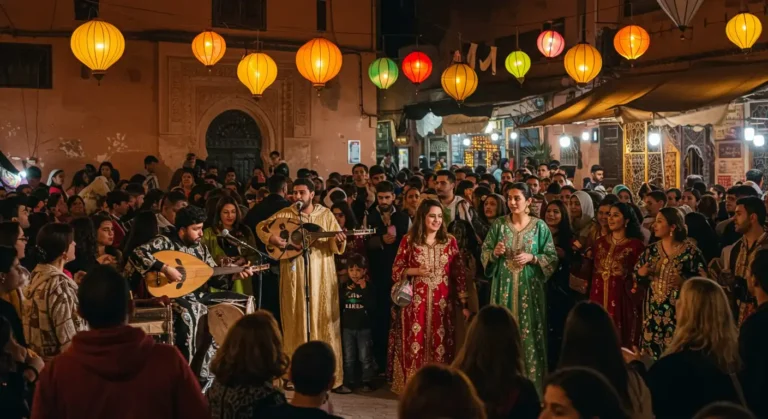Best Time to Travel to Spain, Portugal, and Morocco (With Festivals)
Table of Contents
If you’re planning a trip that combines rich history, stunning landscapes, and unforgettable cultural experiences, then traveling through Spain, Portugal, and Morocco might just be the dream itinerary you’ve been dreaming about.
But here’s the thing: timing really does matter especially when you’re weaving three culturally distinct countries into one journey.
You want good weather, yes. But more than that, you probably want to experience these places when they come alive , when streets are filled with music, colors burst in parades, and traditions take center stage at local festivals.
In this post, I’ll walk you through:
- When to go for the best weather
- Which festivals make each country shine
- How to plan a smooth multi-country trip
- Insider tips to save money and avoid crowds
Let’s dive in!
Understanding the Best Travel Seasons Across Spain, Portugal, and Morocco
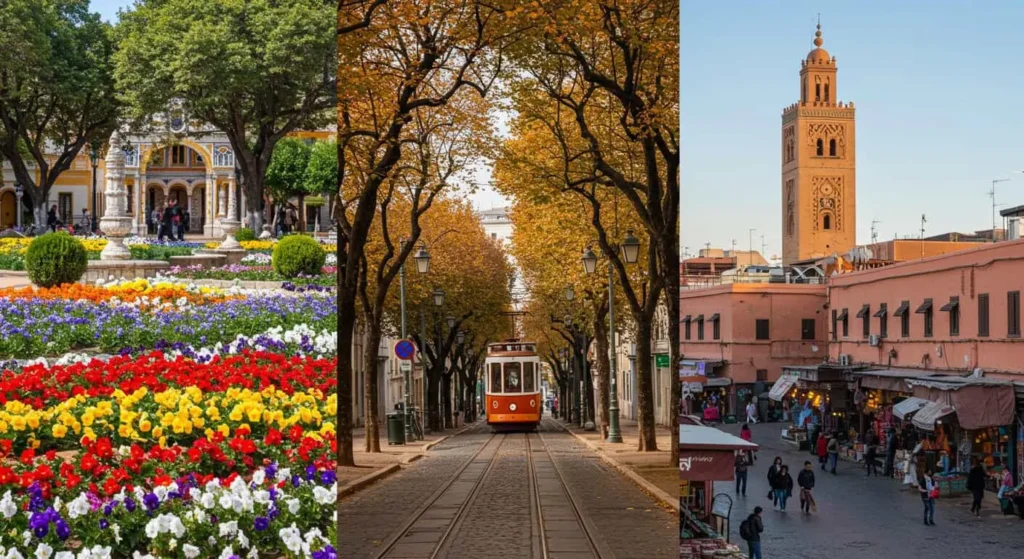
Before we jump into festivals, let’s talk seasons . because no one wants to visit Morocco in July only to melt under the desert sun or arrive in Lisbon during stormy winter rains.
Each of these countries has its own rhythm, but there are sweet spots where all three align beautifully.
Spring (March–May): A Perfect Blend of Weather and Culture
Spring is my personal favorite time to travel across this trio of destinations.
The temperatures are warm but not scorching. think 20°C (68°F) in Lisbon, 25°C (77°F) in Barcelona, and around 27°C (80°F) in Marrakech. It’s the perfect balance between comfort and vibrancy.
This season also marks the beginning of many local celebrations. In Portugal , you’ll find smaller village festivals kicking off, while Spain gears up for events like La Mercè later in the year. In Morocco , spring means blooming roses in the Atlas Mountains setting the stage for the famous Rose Festival in May.
Autumn (September–November): Avoid Crowds and Festival Fever
If you prefer fewer tourists and still want festival energy, autumn is ideal.
By September, summer crowds have thinned out, but the weather remains pleasant especially in coastal areas. Plus, many major festivals are held during this time.
One highlight? The World Sacred Music Festival in Fez, Morocco, usually takes place in late September or early October , a deeply spiritual and colorful event that draws travelers from around the globe.
Autumn is also a great time to explore historic cities without sweating through your clothes.
Summer vs. Winter: Pros and Cons by Country
Now, let’s break down what to expect if you’re thinking of visiting in summer or winter .
| Season | Spain | Portugal | Morocco |
| Summer (June–August) | Hot inland (35°C+), cooler coastlines | Warm but manageable | Very hot inland (40°C+), coastal areas better |
| Winter (December–February) | Mild south, cold north | Cool but rarely freezing | Mild days, chilly nights |
Summer is peak tourist season in Spain and Portugal , which means higher prices and crowded beaches. Morocco gets extremely hot inland, so it’s best avoided unless you’re heading to the coast or mountains.
Winter brings milder conditions to southern Spain and Morocco, but northern Portugal can get rainy and cool.
So unless you’re chasing specific events like Christmas markets or New Year celebrations, aim for spring or fall .
Top Festivals to Plan Your Trip Around
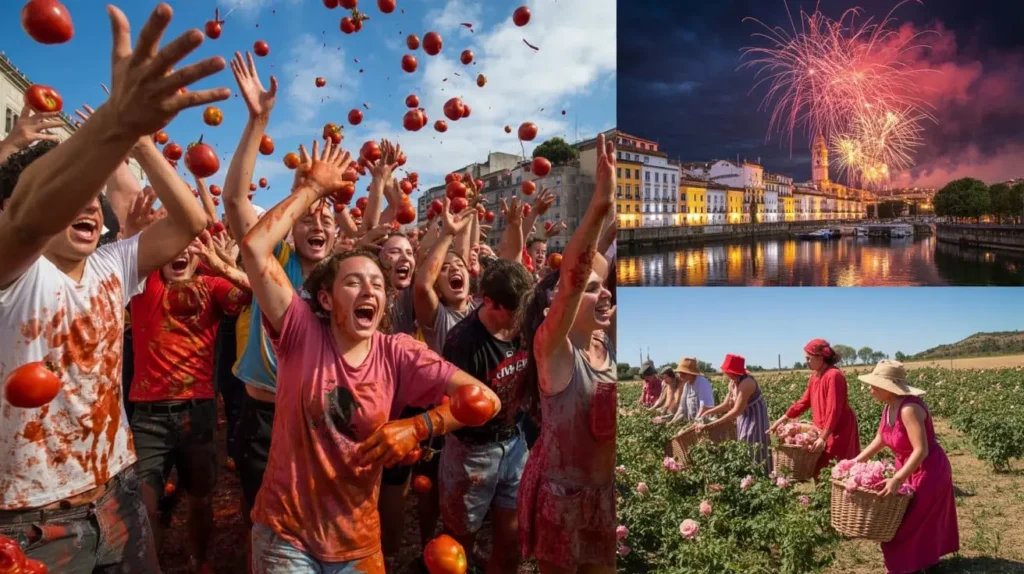
Festivals are where these countries truly shine . they’re vibrant, immersive, and often deeply rooted in centuries-old traditions.
Let’s look at some of the most iconic ones you should consider planning your trip around.
Spain’s Most Iconic Festivals
Spain doesn’t do things halfway. their festivals are loud, messy, joyful, and unforgettable.
- La Tomatina (August, Buñol) : The world’s largest tomato fight. Yes, it’s as chaotic and fun as it sounds.
- San Fermín (July, Pamplona) : Famous for the Running of the Bulls, this week-long celebration is intense and thrilling.
- Semana Santa (Holy Week, March/April) : Religious processions, floats, and solemn beauty mark this Easter-time tradition.
- La Mercè (September, Barcelona) : Fire dancers, castles, fireworks, and street parades. Barcelona goes all out.
Tip: Book accommodations months in advance if attending any of these. hotels fill up fast!
Celebrating Tradition in Portugal
Portuguese festivals blend religious devotion with lively street parties and regional pride.
- Festa de São João (June 23–24, Porto) : Street dancing, garlic necklaces, and midnight fireworks over the Douro River.
- Festival of Saint Anthony (June 12–13, Lisbon) : Colorful parades, grilled sardines, and neighborhood celebrations.
- Queima das Fitas (April/May, Coimbra) : A student festival celebrating academic life with music, costumes, and marching bands.
These events give you a chance to connect with locals and experience Portugal’s warm, community-centered spirit.
Moroccan Festivals: Color, Culture, and Community
Moroccan festivals are less commercialized and more authentic . often tied to agriculture, spirituality, or ancient Berber customs.
- Rose Festival (May, Kelaat M’Gouna) : Thousands gather to celebrate the harvest of Damask roses used in perfumes and oils.
- Imilchil Marriage Festival (September) : A traditional gathering where marriages are arranged among Amazigh (Berber) tribes.
- World Sacred Music Festival (September, Fez) : Spiritual performances from around the world in one of Morocco’s holiest cities.
Unlike European festivals, these are often quieter affairs : but no less meaningful. They offer a rare glimpse into rural life and ancient traditions.
If you’re planning a deeper dive into Moroccan travel timing, check out our full guide on the best time to visit Morocco month-by-month , including festival dates, weather insights, and local tips.
Month-by-Month Breakdown: When to Visit Each Country
To help you decide exactly when to go, here’s a quick month-by-month guide tailored to weather, festivals, and crowd levels .
Spain – Best Months for Weather and Festivals
- April : Mild temperatures + Semana Santa
- May : Great weather + pre-festival buzz
- June : Warm, festive, but getting busy
- September : Post-summer calm + La Mercè
- October : Quiet and comfortable
Avoid July–August in inland areas due to extreme heat.
Portugal – Mild Climates and Cultural Celebrations
- May : Pleasant + Festa de São João prep
- June : Busy with festivals + warmer temps
- September : Cooler + fewer crowds
- October : Off-season deals available
- April : Rainy in the north, better in the south
Coastal regions like the Algarve are popular year-round, but spring and fall are ideal.
Morocco – Avoid Extremes, Embrace Events
- March : Warming up + pre-festival season
- April–May : Ideal temps + Rose Festival
- September–October : Back-to-back festivals
- November : Cooling down, perfect for travel
- December–February : Chilly nights, mild days
Avoid summer unless you’re heading to high-altitude areas like the Atlas Mountains.
Practical Tips for Multi-Country Trips: Spain, Portugal & Morocco
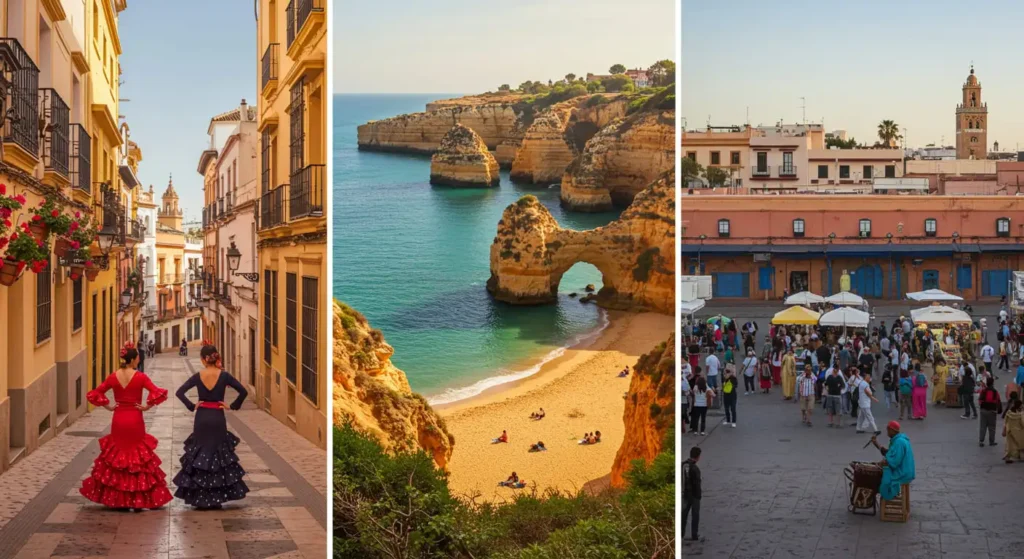
Combining three countries into one trip might sound ambitious, but with smart planning, it can be incredibly rewarding.
Here are some key tips to make it work smoothly.
How Many Days Do You Need?
I recommend at least 7–10 days to comfortably explore all three countries.
A sample itinerary could look like:
- Days 1–3 : Explore Barcelona and Andalusia (Spain)
- Days 4–6 : Head to Lisbon and Porto (Portugal)
- Days 7–10 : Fly to Marrakech or Fez (Morocco)
This gives you enough time to soak in the culture without feeling rushed.
Navigating Borders and Transportation
- Fly between Spain and Morocco, direct flights from Barcelona or Madrid to Marrakech/Casablanca are common.
- Trains and buses work well from Spain to Portugal, though overnight buses may not be comfortable.
- A ferry from Tarifa (Spain) to Tangier (Morocco) is an adventurous option .
Use apps like Omio or Rome2Rio to compare routes and book tickets.
Budgeting for Festivals and Peak Times
Festival dates = price spikes. Accommodation and flights will cost more, so book early.
Pro tip:
- Stay outside city centers during festivals
- Look for Airbnb-style rentals instead of hotels
- Book flights at least 2–3 months in advance
Also, keep in mind currency differences:
- Spain & Portugal use the Euro (€)
- Morocco uses the Dirham (MAD)
Make sure to exchange some cash before arriving in Morocco ATMs are reliable, but credit cards aren’t always accepted in rural areas.
Frequently Asked Questions :
Here are the most commonly asked questions about traveling to Spain, Portugal, and Morocco.
What is the best time to go to Spain, Portugal, and Morocco?
The best time to visit all three is during spring (March–May) or early autumn (September–November) . These months offer mild weather, fewer crowds, and access to major festivals.
Can you do Spain, Portugal, and Morocco together?
Absolutely! Start in Spain, cross into Portugal, and fly or ferry to Morocco for a seamless, diverse trip that blends European charm with North African magic.
What month is the best time to go to Morocco?
The best months to visit Morocco are March–May and September–November . Temperatures are comfortable, and you’ll catch major festivals like the Rose Festival and World Sacred Music Festival.
What is the average temperature in Morocco by month?
| Month | Avg High (°C) | Avg Low (°C) |
| January | 19°C | 8°C |
| April | 25°C | 12°C |
| July | 35°C | 22°C |
| October | 28°C | 16°C |
Temperatures vary depending on region — mountainous areas are cooler, deserts are hotter.
What is the cheapest month to go to Morocco?
The cheapest months to visit Morocco are typically December–February (excluding holidays) . Flights and accommodation drop significantly during these periods.
Final Thoughts
Traveling through Spain, Portugal, and Morocco is more than just ticking off destinations . it’s about immersing yourself in cultures, histories, and traditions that feel alive and ever-evolving.
And when you time your trip right, especially around festivals you’ll experience these countries at their most magical.
Whether you’re dancing in the streets of Porto, dodging tomatoes in Buñol, or marveling at sacred chants in Fez, you’ll come away with memories that last a lifetime.
So, grab your calendar, pick your dates, and start planning your adventure. You won’t regret it.

